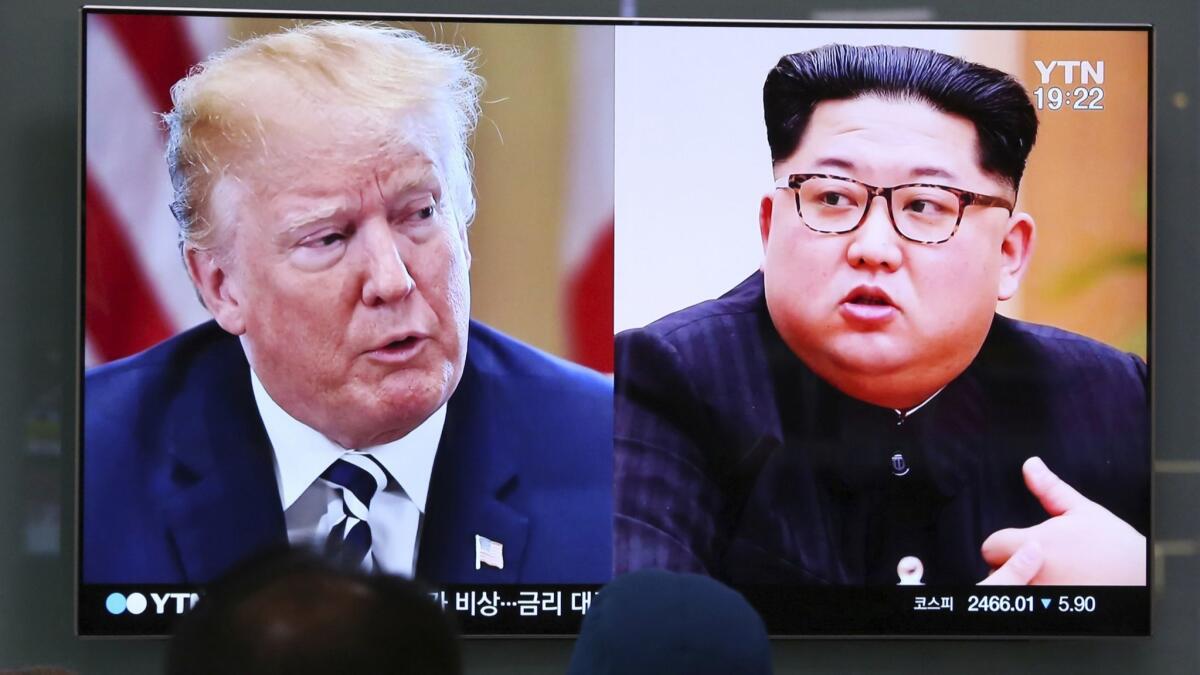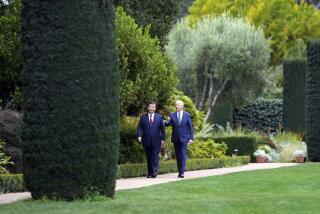Op-Ed: The Trump-Kim summit is marked by more angst than optimism

The summit between President Trump and Kim Jong Un is about to begin even though the two sides remain far apart on critical issues.
Lost amid last month’s on-again, off-again missives was a crucial signal. North Korean First Vice Minister of Foreign Affairs Kim Kye Gwan publicly rejected U.S. demands that the dictatorship rapidly, verifiably and irreversibly abandon its nuclear arsenal before getting any rewards. Instead, he reiterated long-standing demands for U.S. security and economic concessions in return for any constraint on Pyongyang’s nuclear programs, and he affirmed that North Korea would not engage in unilateral disarmament.
A senior U.S. official recently acknowledged that the administration still did not know “whether Kim Jong Un had made a decision to denuclearize.” South Korean Minister of Unification Cho Myoung-gyon said in late May that the difference between the U.S. and North Korea on denuclearization remains “huge [and] it won’t be easy to narrow this gap.” Yet Trump is going ahead with the summit anyway.
Trump has strongly criticized preceding agreements with North Korea. He pulled out of what he called an “insane” Iran nuclear deal. That sets a high bar for success at tonight’s meeting: The president must attain an unequivocal commitment from Kim to abandon his WMD programs in the “complete, verifiable and irreversible” manner required by UN resolutions related to North Korea that go back to 2006. It will take more than just words on North Korea’s part.
Kim must provide a complete declaration of North Korea’s nuclear, chemical, biological and missile production, fabrication, test and storage facilities, fissile material and weapons of mass destruction arsenals; agree to the dismantlement of those facilities and destruction of the regime’s nuclear, biological and chemical arsenals; and accept a robust verification regime including short-notice challenge inspections of non-declared facilities.
Kim Jong Un will try to string out the process as long as possible to get the maximum benefit with minimum sacrifice.
In essence, Trump will have to achieve an agreement that is tougher and more comprehensive than the one he scrapped with Iran. Iran gave up 97% of its nuclear material, shut down thousands of centrifuges and accepted strict limitations on its nuclear development that would last a minimum of 10 to 15 years. International inspectors could examine Iranian nuclear facilities, and the International Atomic Energy Agency could install cameras to monitor them. The Iran deal had significant flaws — it came with an expiration date, did not cover Iran’s non-nuclear activities and did not include automatic access for inspectors to all Iranian military facilities — which the Trump administration will need to remedy in any accord with North Korea.
And yet, this wasn’t the president’s message in the days before he left for Singapore. After meeting with senior North Korean official Kim Yong Chol on June 1, Trump said he put “hundreds” of North Korean sanctions in abeyance because “we’re talking so nicely” with Pyongyang. In addition, the Treasury Department deferred the implementation of sanctions against three dozen Russian and Chinese entities providing prohibited support to North Korea. The White House also has not taken action against the dozen Chinese banks that Congress recommended be sanctioned for their dealings with North Korea.
Nor did Trump make clear what economic, diplomatic or security benefits Kim could get in return for denuclearization. Instead, Trump commented that a peace treaty “could come out of the meeting. ... We talked about ending the war.” But while formally ending the Korean War would be historic, it would be a disaster to give up this leverage prematurely.
Concluding a peace treaty could end the legal justification for the United Nations Command in South Korea and create momentum in Seoul and Washington for the withdrawal of U.S. troops from the Korean peninsula. That would be premature unless the North Korean nuclear threat is largely eliminated and the North has agreed and even begun to reduce the conventional threat.
Kim Jong Un will try to string out the process as long as possible to get the maximum benefit with minimum sacrifice. Trump must push hard enough to get real concessions — but not so hard that the diplomatic process breaks down entirely. That is a challenge that would test the mettle of even the most experienced diplomat. Perhaps Trump’s unpredictability and business acumen can carry the day in his meeting with Kim. But Trump’s fly-by-the-seat-of-your-pants approach generates more angst than optimism.
Sue Mi Terry, senior fellow for the Korea Chair at the Center for Strategic and International Studies, previously served as senior analyst on Korean issues at the CIA and director for Korea, Japan and Oceanic Affairs at the National Security Council. Bruce Klingner, senior research fellow for Northeast Asia at the Heritage Foundation, previously served as the CIA’s deputy division chief for Korea.
Follow the Opinion section on Twitter @latimesopinionand Facebook
More to Read
A cure for the common opinion
Get thought-provoking perspectives with our weekly newsletter.
You may occasionally receive promotional content from the Los Angeles Times.





